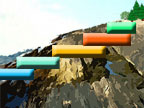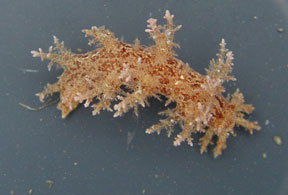 |
 |
|||||||||||||||
|
Nudibranchs (new-di-branks) are shell-less gastropods, commonly called sea slugs. The image to the left is the maned nudibranch, Aeolidia papillosa. The nudibranch on the left is the bushy-backed sea slug, Dendronotus frondosus.These species are found in crevices and tide pools in the lower intertidal and subtidal areas. Aeolidia papillosa has been called the 'maned nudibranch' because of its dense cloak of cerata, which cover the body. Its color varies from pinkish to smoky-gray to brown. The bushy-backed sea slug is identified by the double row of bushy cerata on its back. Its color can vary from the usual mottled reddish brown to white. While the nudibranch appears to be vulnerable without a shell, they have other defenses. The cerata store hundreds of stinging cells or nematocysts which are collected during feeding on hydroids and anemones. These nematocysts are the only protection the nudibranch needs. The egg masses of these species are commonly found near anemones. The mass is a curvy, coiled chain of egg packets. Egg color varies from white to pink and orange. Follow this link to the Image Library to see a nudibranch egg mass. |
||||||||||||||||
|
||||||||||||||||
|
||||||||||||||||


